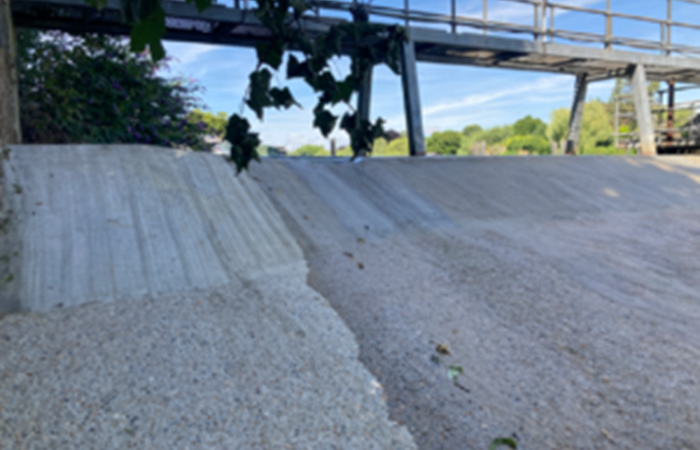Environment Agency

The transformation has seen a 750% increase in the numbers of this critically endangered species successfully bypassing the weir.
Weirs are essential for managing river levels but present an obstacle to fish such as eels trying to swim upstream. The weirs at Molesey on the River Thames have been a particular bottleneck for eels, whose presence are an important indicator of the environmental health of the waters they live in.
Last summer, fisheries officers noticed that more eels were trying to navigate a smaller weir nearby, rather than the main one. This smaller weir had no eel pass, and camera monitoring revealed that most of the eels efforts were in vain. Even those who made it up the main slope came up against the crest at the top, where a hungry heron waited to pick them off!
An immediate fix was needed, as it was in the middle of the eel migration season. Officers installed a simple rope ramp to try to help the eels up and over the crest. And with the use of camera monitoring were able to see some improvement, but a better solution was needed long-term.
The team set to work and created the new eel pass. The team did this by smoothing out the vertical crest that the young eels had been attempting to climb, creating a concrete slope instead. The surface was roughened to provide more grip for the eels to crawl against. Because eels are long and thin, they are very good at wriggling and crawling.
Steve Sheridan, Thames Fisheries officer, said:
This new eel pass is designed to help eels wiggle all the way over in a range of different water levels and flows, aiding their success rate in travelling upstream. We hope we have played our part in helping some of the thousands of eels that travel through our network of waterways each year reach maturity and continue their lifecycle journey.
During the peak of migration this season from May to July, anywhere between 5,000 and 45,000 eels could be successfully getting over the weir via the eel pass. I estimate that up to 500 are making it over each night.
With the help of ZSL (the Zoological Society of London), the team also provided data to a Master of Science student from University College London to evaluate the effectiveness of the new eel pass. Results demonstrated the weir adaptation has improved eel passage (compared to last summers temporary solution) by 750%.
This year, the new pass will be in place for the whole eel migration season from May to September. It is expected that thousands of eels will make it further upstream.
The novel low-tech eel pass has been demonstrated to be a highly effective solution. The fisheries team plan to replicate it at other sites to provide low-cost, low-maintenance passage for eels.
Eels are born in the Sargasso Sea in the north-west Atlantic Ocean. From there, they float in their larval form on ocean currents towards Europe journeying 4,000 miles over two years. Once they reach freshwater estuaries, they turn into elvers (young eels, up to 12cm long) and swim up into rivers, including the River Thames. Here they live for up to 20 years, before returning to the Sargasso Sea as mature
